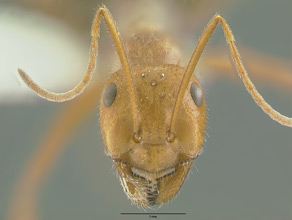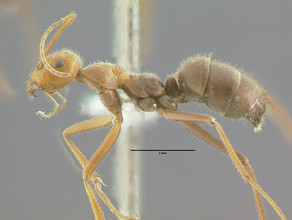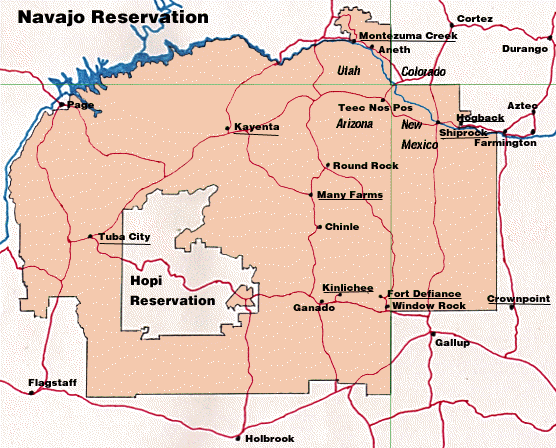- Identification
- The genus Myrmecocystus can be differentiated from other Nearctic Formicinae by their elongate maxillary palpi. The fourth segment is as long as, or longer than, the combined lengths of the two following segments. Myrmecocystus mendax can be separated from other Navajo Reservation Myrmecocystus by a combination of their small eyes, pilosity and their coloration. The body and appendages of the polymorphic workers are varying shades of yellow to brown-ferruginous, with a medium to dark brown gaster.
- Biology
- Nests in hard stony soil, often on hill slopes. There may be one of more nest entrances that are either bare or marked by a small and irregular crater tumulus. Nest chambers may also be found under stones. Exposed entrances are irregularly shaped and can be rather large (2- 3.5 cm) compared to the size of the workers. Wheeler (1908) found mature colonies of this species (reported as Myrmecocystus orbiceps, a synonymy of mendax) contained up to 500 workers.
- additional biology notes...
- Distribution
- Range
- United States and Mexico. Central Colorado south to Texas, west to desert mountain ranges of southeastern California, northern Mexico.
- Navajo Reservation Records
- Species records being processed.

Drawing of worker from Snelling (1976)
- Additional Notes
- Foraging is diurnal. Workers are general scavengers, will actively prey on other insects and collect honeydew and nectar when available. Mating flights take place during the summer rainy season. Like many other Myrmecocystus species the workers are polymorphic.
- Repletes
- Myrmecocystus are better known to naturalists by their common name - honeypot ants. While there are numerous varieties of honeypot ants throughout the world this particular genus is restricted to dry habitats in southwestern North America. Individual species can be found from Washington, south to central Mexico and east to Texas. The genus is most diverse in southern California, which hosts eighteen of the twenty-seven named species. The common name of the ants from this genus highlights an unusual feature of their biology. One of the worker castes serves as a living food storage repository. These large workers, or repletes, have gasters that are able to expand to a remarkable degree.
- Repletes are a fascinating adaptation to arid and semi-arid habitat life. Myrmecocystus live in areas where rain is sparse and typically arrives seasonally. The moisture triggers plant growth and reproduction, which in turn creates food resources for many other organisms. Carbohydrate rich exudates of sap sucking insects (aphids and others), galls and extrafloral nectories can readily be gathered in great quantities by foraging ants. Over the course of the year nothing else compares to this seasonally abundant profusion of liquid nutrients. Repletes are an effective way of solving the problem of dealing with the boom and bust nature of these valuable liquid food resources.
- Nests of Myrmecocystus go deep underground and the repletes are typically located in the lower reaches of the nest. Snelling (1976) felt they were placed where there is permanent soil moisture. This positioning of the repletes in the soil column allows for the ants to be kept cool and maintained in a humid environment. The deeper confines of the nest are also presumed to be safer from predators that could potentially prey upon the nutrient rich ants. Other ants, badgers, coyotes and even humans have exploited honeypot ants as a food resource.
- Foraging ants collect honeydew and nectar, return to the nest and regurgitate their food to the repletes. These living storage units suspend themselves from the ceiling of a nest chamber. Individuals are often found in clusters while overall they may be found in numerous chambers in a colony. Engorged individuals can become confined to the chamber where they become filled with liquid. The repletes of some species become the size of small grapes. The transfer of food is reversed during leaner times of the year. Workers will tap their antenna upon the head, mandibles and antenna of a replete to solicit food, which is then readily provided to the repletes' nestmates.
- Etymology
- Unknown association / use of mendax - Latin for lying, false
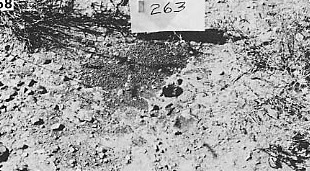
Photograph of nest entrance from Snelling (1976)
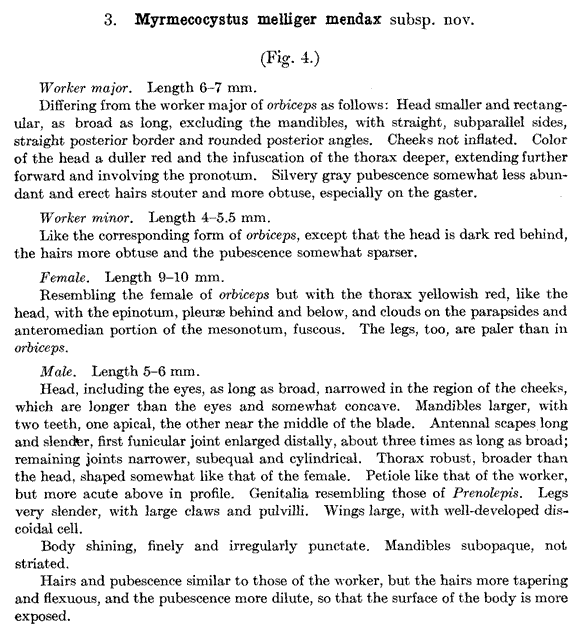

Myrmecocystus melliger subsp. mendax: unspecified number of cotypes of all castes from Mt. Washington, near Colorado Springs, Colorado, July 19, 1903 (W. M. Wheeler). Lectotype worker, by present selection, agreeing with above general description and parenthetical data, in AMNH; lectoparatypes, all castes in AMNH, LACM, MCZ.
Myrmecocystus melliger subsp. orbiceps: an unspecified number of worker and female cotypes from Bull Creek, near Austin, Texas (Brues , Melander and Wheeler). Lectotype worker, by present selection (HL 1.85, HW 1.85, SL 2.25, WL 2.85, PW 1.25 mm), agreeing with above general description and Edwards Plateau specifics, in AMNH; lectoparatypes in AMNH, LACM, MCZ.
As stated in Snelling (1976).
- Literature
- Snelling, R. R. 1976. A revision of the honey ants, genus Myrmecocystus (Hymenoptera: Formicidae). Natural History Museum Los Angeles County Science Bulletin. 24:1-163.
- Wheeler, W. M. 1908. Honey ants, with a revision of the American Myrmecocysti. Bulletin of the American Museum of Natural History. 24:345-397.
- A note about these publications. The literature cited here is not meant to be an exhaustive list of papers published about this species.
Page authored by David Lubertazzi and Gary Alpert
